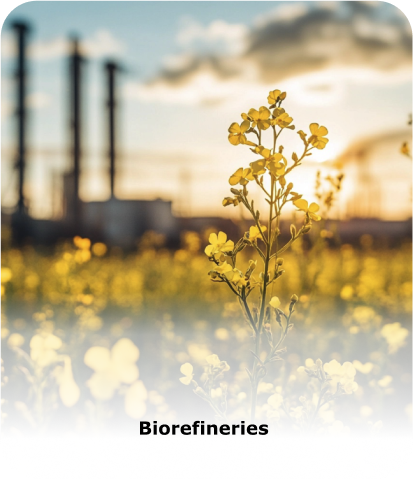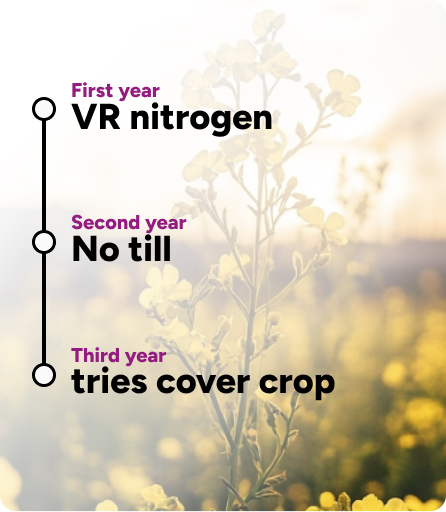Mission of xarvio® Bioenergy
Biorefinery-centric tool from BASF for reporting and verifying feedstock CI, helping biorefineries monetize low CI feedstocks to help maximize low-carbon fuel produced and associated potential tax credits.
Overview of xarvio®
BIOENEGRY
We focus on understanding and meeting farmers’ needs in partnership with their trusted advisors. Digital farming helps maximize outcomes, resulting in greater convenience and assurance.

Primary Benefits

Helps ethanol producers monetize low-CI feedstocks to maximize low-carbon fuel produced and associated potential tax credits.

Get access to data validated by a trusted third-party to facilitate program compliance and establish simplified customer relationship management.

Use for calculating, consolidating, to facilitate verification and reporting feedstock carbon intensity.
LCIC Mission & Overview
Low Carbon Intensity Crops (LCIC) is an integrated service from BASF and Anew Climate committed to helping maximize the benefits for farmers, retail agronomists and biorefineries. Our shared mission is to make low-CI grain valuable and achievable for all parties across the biofuel value chain.

Connecting Solutions Together For Customers

Everybody Benefits
- Biorefineries that may be eligible for the 45Z tax credits can produce a higher value biofuel with the right documentation for low CI feedstocks.
- Farmers may be eligible to earn a premium for their documented low-CI crops through a participating biorefinery.
- Retailer Agronomists benefit through added sales and services offered to farmers to help maximize yield and lower CI.
How LCIC works
Connect farmers, retail agronomists, and biorefineries

- Farmers work with retail agronomists to track and calculate low-CI efforts for a potential premium price from biorefineries who purchase grain for low-CI fuels.
- Produce low-CI corn for a premium price from biorefineries that buy corn for low-carbon fuels

- Provide agronomic expertise
- Facilitate data capture with BASF’s xarvio FIELD MANAGER to alleviate burden of data collection on growers
- Benefit from additional touchpoints and new value-selling opportunities

- Utilize plant-centric tool, BASF’s xarvio Bioenergy for reporting and verifying CI
- Get verifiable data to monetize low-CI feedstocks
- Maximize the amount of low-carbon fuel produced and associated tax credits
- Determine farmer incentives
How LCIC helps
Low Carbon Intensity Crops (LCIC) is an integrated service from BASF and Anew Climate committed to helping maximize the benefits for farmers, retail agronomists and biorefineries. Our shared mission is to make low-CI grain valuable and achievable for all parties across the biofuel value chain.

Solution for
FARMERS
Farmers contract with a Biorefinery and work with their trusted advisors to collect the required data. An example of a biorefinery to partner with is an ethanol plant. Ethanol plants will vary in their ability to pay 45Z-related incentives to farmers. Ethanol plants will also vary in how they procure their corn (direct delivery, contracted through local elevators or commercially). There’s a high risk associated with “scoring my own corn” and then trying to find a buyer, so farmers want to find a biorefinery that uses a digital ecosystem with real incentives for them once they provide the required data. Qualifying practices that are expected to lower CI under 45Z include tillage reduction (no-till, strip-till, vertical till), cover crops and enhanced efficiency fertilizers (coated urea, nitrification inhibitors, urease inhibitors.
Farmers work with their trusted advisors to collect their CI score data to partner with a biorefinery. An example of a biorefinery to partner with is an ethanol plant. Ethanol plants will vary in their ability to pay 45Z-related incentives to farmers. Ethanol plants will also vary in how they procure their corn (direct delivery, contracted through local elevators or commercially). There’s a high risk associated with “scoring my own corn” and then trying to find a buyer, so farmers want to find a biorefinery that uses a digital ecosystem with real incentives for them once they provide the required data. Qualifying practices to lower CI under 45Z include tillage reduction (no-till, strip-till, vertical till), cover crops and enhanced efficiency fertilizers (coated urea, nitrification inhibitors, urease inhibitors.

Solution for
AGRONOMISTS
Trusted advisors such as Retail Agronomists facilitate data capture with xarvio® FIELD MANAGER from BASF to alleviate burden of data collection on farmers. LCIC provides retail advisors with the ability to give their farmers real and tangible biofuel incentives. It also empowers the agronomist to have in-depth and ongoing discussions about how to grow input and production practices.

Trusted advisors such as Retail Agronomists facilitate data capture with xarvio® FIELD MANAGER from BASF to alleviate burden of data collection on farmers. LCIC provides retail advisors with the ability to give their farmers real and tangible biofuel incentives. It also empowers the agronomist to have in-depth and ongoing discussions about how to grow input and production practices.

Solution for
BIOREFINERY
Biorefineries utilize the BASF plant-centric tool xarvio BIOENERGY for reporting and verifying feedstock CI. They receive verifiable data to monetize low-CI feedstocks and maximize the amount of low-carbon fuel produced and associated tax credits. LCIC biorefineries get access to data validated by a trusted third-party to ensure program compliance. To maximize the amount of low-carbon fuel produced and the associated tax credits, it’s important for biorefineries to secure low carbon crops from participating farmers by way of financial incentives.
Farmers work with their trusted advisors to collect their CI score data to partner with a biorefinery. An example of a biorefinery to partner with is an ethanol plant. Ethanol plants will vary in their ability to pay 45Z-related incentives to farmers. Ethanol plants will also vary in how they procure their corn (direct delivery, contracted through local elevators or commercially). There’s a high risk associated with “scoring my own corn” and then trying to find a buyer, so farmers want to find a biorefinery that uses a digital ecosystem with real incentives for them once they provide the required data. Qualifying practices to lower CI under 45Z include tillage reduction (no-till, strip-till, vertical till), cover crops and enhanced efficiency fertilizers (coated urea, nitrification inhibitors, urease inhibitors.

FAQ
CI is the amount of Greenhouse Gas (GHG) used to produce a product.
CI is important because policymakers are incentivizing the decarbonization of fuels. Various federal and state programs in the U.S. and Canada are emerging to lower the CI of fuels.
CI is calculated using a Life Cycle Assessment (LCA) model. A LCA model is a method of evaluating the environmental impact of a product throughout its whole life cycle. The fuel industry and Department of Energy use the GREET model as their LCA.
Pending the final 45Z ruleset, climate smart farming practices like reduced tillage, no-till, and using cover crops can sequester carbon into the soil. Nitrogen fertilizer stabilizers can reduce the amount of nitrous oxide released from the soil. Other practices, like using green ammonia and manure, could be options as well. Raising yield can also potentially lower CI.
xarvio® FIELD MANAGER is a digital farming platform built to empower the farmers’ trusted advisor, the retail agronomist. It provides unique insights on pest and disease prediction. When used in conjunction with a participating biorefinery using xarvio BIOENERGY, it also calculates carbon intensity and captures necessary data to meet verification requirements. All of this information is passed securely and directly to the LCIC biorefinery, via xarvio Bioenergy, so the biorefinery can get the verifiable data it needs to report its CI to the regulatory agencies and monetize low-CI grain.





 Argentina (español)
Argentina (español)  Brazil (Portuguese)
Brazil (Portuguese)  Canada (English)
Canada (English)  France (Français)
France (Français)  Germany (Deutsch)
Germany (Deutsch)  Global (English)
Global (English)  Japan (Japanese)
Japan (Japanese)  Ukraine (Ukrainian)
Ukraine (Ukrainian)